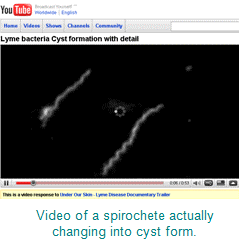Lyme Disease
Lyme disease makes us realize that we can never get rid of all the bugs in our environment; it’s about learning to minimize the effect of the bugs, and learning to live with them.
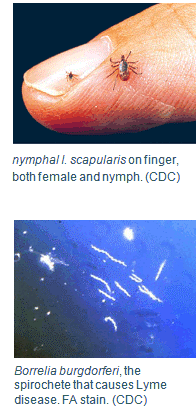 Ixodes ticks, the principal vector for Lyme disease, were present in Massachusetts in the 1920s and 1930s. Ticks from Long Island, New York, collected in the late 1940s/early 1950s, were infected with Lyme. Then in 1975, a cluster of cases brought formal recognition of the disease. A number of children and some adults in the town of Lyme, Connecticut, mysteriously showed up with what looked like rheumatoid arthritis. The disease was named after the town. Eventually Lyme disease spread from the East coast across the country.[1]
Ixodes ticks, the principal vector for Lyme disease, were present in Massachusetts in the 1920s and 1930s. Ticks from Long Island, New York, collected in the late 1940s/early 1950s, were infected with Lyme. Then in 1975, a cluster of cases brought formal recognition of the disease. A number of children and some adults in the town of Lyme, Connecticut, mysteriously showed up with what looked like rheumatoid arthritis. The disease was named after the town. Eventually Lyme disease spread from the East coast across the country.[1]
The organism responsible for Lyme disease was identified in 1981 by Dr. Willy Burgdorfer, and named Borrelia burgdorferi (B. burgdorferi), after its discoverer.[2] It is similar in shape to the spirochete Treponema pallidum, which causes syphilis, the scourge - of Europe for hundreds of years. Syphilis was called “the Great Imitator” because its symptoms mimicked so many other diseases. The same is true with Lyme.
The number of Lyme disease cases in the United States has doubled since 1991. The Centers for Disease Control and Prevention (CDC) states that 30,000 new cases of Lyme are reported to it each year, but estimates the actual number of cases to be ten times higher. That would be 300,000 cases per year in the United States alone,– making Lyme disease an epidemic larger than AIDS, West Nile Virus, and Avian Flu combined.
Lyme disease presents a host of challenges. Once the corkscrew-shaped spirochetes enter the bloodstream, they can cause a wide range of constitutional, musculoskeletal, and neurological symptoms.
B. burgdorferi’s spiral shape aggressively embeds itself, usually first in the joints – when the cluster of Lyme cases showed up in Connecticut, most people complained of arthritis. Then the spirochetes typically go to the muscles and tendons, and can go into the heart and brain. Lyme spirochetes are also pleomorphic, meaning they can change shape, making it hard for the immune system to detect them, and hard for anything you throw at them to destroy them. They manufacture a barrier called biofilm, and hide behind it, again evading detection by the immune system. The strength of one’s immune system often dictates the severity of symptoms. The longer symptoms go untreated, the more intractable they can become.
DIAGNOSING LYME
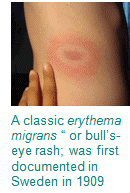 Some victims see a classic “bulls eye” rash from a tick bite, but more than half do not, according to ILADS, The International Lyme and Associated Diseases Society.
Some victims see a classic “bulls eye” rash from a tick bite, but more than half do not, according to ILADS, The International Lyme and Associated Diseases Society.
Recent studies reveal Lyme disease may be transmitted by human-to-human contact, including from mother to fetus.[3] Spirochetes have been found in semen, vaginal fluid,[4] tear ducts, sweat, and mothers’ breast milk.[5] The CDC found Lyme bacteria alive in blood that has been purified for donation. Blood banks do not screen for Lyme, but if admit to having Lyme, you will be told not to donate your blood.[6] Researchers at the University of Wisconsin found dairy cattle infected with the Bb bacterium, which raises the question of whether milk or other products in our food chain may be a danger.[7]
According to ILADS:
“After a tick bite, serologic tests (ELISA. IFA, western blots, etc.) are not expected to become positive until several weeks have passed. Therefore, if [a bulls eye rash] is present, treatment must begin immediately, and one should not wait for results of Borrelia tests. You should not miss the chance to treat early disease, for this is when the success rate is the highest. Indeed, many knowledgeable clinicians will not even order a Borrelia test in this circumstance.”[8]
A good test to determine whether you have Lyme can be hard to come by. The Lyme spirochete can hide in the human body and fool the immune system into thinking it isn’t there by hiding behind a protein wall produced by the spirochete, called “biofilm.” So, antibodies are not produced, resulting in negative tests. The spirochetes can also morph into a different and dormant form, a cyst, which the immune system does not recognize.
The Western Blot test essentially makes a map of the different antibodies the immune system produces to the bacteria. It used to be that virtually every lab had accepted bands 22, 23, 25, 31, and 34 kDa as specific and significant, and reported them as positive for exposure to Borrelia burgdorferi. Then in 1994, the Association of State and Territorial Public Health Laboratory Directors set nationwide standards for Western Blot reporting and disqualified those bands as even being reportable. Currently among Lyme literate doctors, significance is associated with 41 kDa band, which appear the earliest but can cross-react with other spirochetes. The 58 kDa band, on the other hand, is considered to be highly specific in Scotland and other European laboratories.[9a]
One problem with the Western blot test is that it was developed using only a single laboratory grown strain of B burgdorferi. Its specificity is high – in other words, if the test is positive, it’s really positive. But its sensitivity is low – in other words, it may miss up to 40-50% of people who are eventually shown to have Lyme disease.
The ELISA Test (Enzyme-Linked Immunosorbant Serum Assay) is automated. Many different patient samples can be performed by a single machine simultaneously. It may be convenient for the lab, but many consider the ELISA not sensitive enough to serve as an adequate screen, and there are many patients with Lyme who test negative by ELISA yet have fully diagnostic western blots.
A 2005 Johns Hopkins study, published in the Journal of Clinical Microbiology, claims that the CDC’s two-tiered testing procedure, use of both ELISA and Western Blot, misses 75% of positive Lyme cases.[10]
Proving a persistent infection requires that you locate something in the blood. Since spirochetes leave the blood for body tissue, and tissue samples are something best collected at an autopsy, finding evidence can be tough.
Lyme-literate physicians generally prefer to use the IGeneX in California or the ImmunoSciences Lab (also in Calfornia) because their accuracy rates are better. But again, they are not perfect. Other tools can also be helpful:
- measurement of the CD57 natural killer cell level, an immunologic marker that can be used to monitor treatment in chronic Lyme
- if neurologic symptoms are severe, a single-photon emission CT SPECT brain scan to see how much inflammation is present in the brain
- measuring the level of C4a complement – which is generally high with chronic Lyme disease and decreases with successfully treatment – may give a good way to at least measure treatment response. Patients with predominantly musculo-skeletal symptoms have high C4a levels compared with patients with predominantly neurologic symptoms (or with controls).[1]
- positive culture of the Lyme organism in blood is definitive proof of the disease. To date, the only place in the country which cultures the Lyme organism is Advanced Laboratory Services in Pennsylvania.
Clinical diagnosis is key; even the CDC calls for objective physical findings.
THE GREAT IMITATOR
“Objective physical findings” however, run smack into The Great Imitator. That term was first used with syphilis because spirochetes affect people in so many different ways – their symptoms are all over the map. One Lyme patient can look like a case of rheumatoid arthritis, another like fibromyalgia or multiple sclerosis, and yet another can look okay physically but obviously has cognitive issues. Lyme-induced psychiatric illness is sometimes indistinguishable from other psychiatric diagnoses.
 In July 2005, football fans were stunned by newspaper stories that police found Florida State University quarterback Wyatt Sexton doing push-ups in the street and reportedly saying he was the “son of God.” Medical exams later found that Sexton was suffering from advanced Lyme disease. His physician, S. Chandra Swami, reported that the infection caused both neuropsychiatric and cardiovascular defects.[11]
In July 2005, football fans were stunned by newspaper stories that police found Florida State University quarterback Wyatt Sexton doing push-ups in the street and reportedly saying he was the “son of God.” Medical exams later found that Sexton was suffering from advanced Lyme disease. His physician, S. Chandra Swami, reported that the infection caused both neuropsychiatric and cardiovascular defects.[11]
In March 2009, Reverend Fred Winters was confronted outside his Illinois church by a 27 year old man. After fatally shooting Winters, the man pulled out a knife and stabbed himself repeatedly. The killer’s mother explained that her son got Lyme10 years earlier and it had triggered a series of erratic behaviors and mental difficulties.[12]
New York pathologist Dr. Alan MacDonald found B. burgdorferi DNA in 1986 in seven out of ten autopsy samples from the brains of people with Alzheimer’s.[13,14] MacDonald was also the first to document B. burgdorferi in fetal tissue, meaning the infection passes from mother to child in the womb.
Long-term infection with B. burgdorferi for a long time allows the bacteria to replicate and wreak havoc throughout the entire body. The bacteria hide inside nerve cells and destroy them from within. B. burgdorferi also burrows into tendons and ligaments causing inflammation in the tissues and the nearby bone. B. burgdorferi infects the brain causing swelling and interruption of blood flow, and a characteristic pattern of diminished function seen on PET scan.[1]. In some patients, the bacteria invade the heart, resulting in heart block and myocarditis, life-threatening cardiac abnormalities. That is why it is called a multi-system illness.
Lyme can be mistaken for an estimated 350 conditions, including:
| • Alzheimer’s disease • amyotrophic lateral sclerosis (ALS) • chronic fatigue syndrome • fibromyalgia • irritable bowel syndrome • lupus • Bell’s Palsy • memory loss • meningitis • ADHD | • rheumatoid arthritis • scleroderma • multiple sclerosis (MS) • Parkinson’s disease • autism • encephalitis • vertigo • tremors • various autoimmune disorders |
Often, chronic Lyme patients get a diagnosis that actually hinders meaningful treatment when Lyme is the root problem. For example, when Lyme attacks the joints and a person receives a diagnosis of rheumatoid arthritis, typically they are given a prescription for anti-inflammatory steroids. However, steroids suppress the immune system – exactly what you would NOT want to do if you knew you had Lyme. Also, we know that B. burgdorferi can induce secretion of aggrecanase, an enzyme that breaks down cartilage.[15] Steroids do nothing for that.
Let’s look a little more closely at another diagnosis on the list: autism.
 “The epidemics of Lyme and autism have gone from mild ripples in the water to roaring, all-consuming tidal waves, destroying thousands of lives and tearing apart countless families,” said Bryan Rosner and Tami Duncan, co-authors of the book, The Lyme-Autism Connection.
“The epidemics of Lyme and autism have gone from mild ripples in the water to roaring, all-consuming tidal waves, destroying thousands of lives and tearing apart countless families,” said Bryan Rosner and Tami Duncan, co-authors of the book, The Lyme-Autism Connection.
Duncan founded the Lyme-Induced Autism (LIA) Foundation in California. The LIA Foundation estimates the majority of children with autism may be also infected with Lyme disease. Informal studies put the number at about 30 percent; clinicians are reporting up to 90% of the children with autism testing positive for B. burgdorferi. At the LIA Foundation’s June 2008 conference, several experts suggested that at least 70% of the population has Lyme, and that it is being passed to children through congenital transmission, possibly through DNA. Dr. Dietrich Kinghardt said, “Most autistic kids have Lyme disease because most docs do not treat for Lyme first to knock it down enough that the white blood count can mount an attack and give you something to measure; that is why it is unknown.”[16]
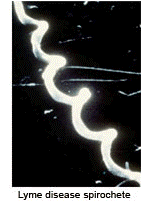
THE POLYMORPHIC SPIROCHETE
Lyme disease starts with an attack of spirochetes. The tip of the Borrelia burgdorfei spirochete can spin and twirl until it stimulates the cell’s own enzymes to digest a part of the membrane, allowing entry. Once inside, the spirochete can lie dormant, protected from both the immune system and the action of antibiotics.
The cell division time of B. burgdorferi is very long compared to other bacteria. Strep and staph cells, for example, divide in less than 20 minutes. B. burgdorferi takes 12-24 hours to divide and this is a key reason Lyme is so hard to knock out. Most antibiotics are effective at the moment when bacteria are dividing because antibiotics inhibit the creation of a new cell wall.
https://www.youtube.com/watch?v=lVmCa70bAxE
When Lyme spirochetes encounter antibiotics, they can go into cyst form very quickly. Most reserachers feel the cyst form is impervious to antibiotics, although some physicians have had success with metronidazle (Flagyl) and tinidazole and the non-drug, grapefruit seed extract.[17]Cysts are small sacs containing immature spirochetes. Eventually the sacs might lodge in tissue or travel the blood stream where white blood cells sense their foreign presence but have little ammunition to kill them.
Spirochetes have the ability to burrow into or between cells and hide, gaining protection from the immune system. Both B. burgdorferi and Treponema pallidum, the causative agent for syphilis, have highly unusual outer membranes; the molecular architecture of these membranes is responsible for their ability to cause persistent infection.
THE CO-INFECTIONS
Ticks harbor more infections than just B. burgdorferi. Some of the most common are bartonella, babesia, ehrlichia, mycoplasma, chlamydia, anaplasma, and Rocky Mountain spotted fever. Sometimes, these co-infections are more common and more debilitating than B. burgdorferi itself.
A 2004 New Jersey study examined the prevalence of coinfections in Ixodes ticks that transmit Lyme disease and found the prevalence of B. burgdorferi infection was 33.6%, but the prevalence of Bartonella infection was 34.5%. Thus, Bartonellaspecies were found more often in that geographical area than the Lyme spirochete in these ticks.[18]
Dr. Garth Nicolson, PhD, well known in the Lyme community for his study of chronic intracellular infections, identified a variety of infections present in common chronic conditions:
| Condition identified by Symptoms | Infections Commonly Observed |
| Amyotrophic Lateral Sclerosis (ALS) | Mycoplasma fermentans (and other species), Borrelia burgdorferi, HHV6, Chlamydia pneumoniae |
| Multiple Sclerosis (MS) | Chlamydia pneumoniae, Mycoplasma species, Borrelia burgdorferi, HHV6 and other Herpes viruses |
| Alzheimer’s Disease | Chlamydia pneumoniae, Borrelia burgdorferi, HSV1 and other Herpes viruses |
| Parkinson’s Disease | Helicobacter pylori, coronavirus, Mycoplasma species |
| Autism Spectrum Disorders | Mycoplasma fermentans (and other species), Chlamydia pneumoniae, HHV6, Borrelia burgdorferi |
| Chronic Fatigue Syndrome | Mycoplasma pneumoniae (and other species), Chlamydia pneumoniae, Borrelia burgdorferi |
 https://www.youtube.com/watch?v=wwY26RIWSpU&noredirect=1
https://www.youtube.com/watch?v=wwY26RIWSpU&noredirect=1Singer Daryl Hall of the rock group Hall & Oats had to cancel tour dates in 2005 because of unexplained fevers and tremors. At his girlfriend’s advice, he got tested for Lyme and found four co-infections. He went public with his story because he feels chronic Lyme disease needs to be acknowledged as a serious health issue.
“There are two very, very strong-feeling camps. One camp is really sure that if you’re bitten by a tick you get tests, medicine. But with the chronic disease, that won’t put a dent in it. It manifests in so many ways. It can lead to heart disease, depression. It can be so serious that people have died. It’s a battle,” said Hall.[19]
 Co-infections present their own set of challenges for physicians and patients. Agents used to kill B. burgdorferi may not even touch the co-infections. “Many an ‘incurable’ Lyme patient has discovered the existence of a second, lurking disease – ehrlichiosis or anaplasmosis – only to be treated with doxycycline and, finally, get well,” author and Lyme patient Pam Weintraub documented in Cure Unknown-Inside the Lyme Epidemic.[20]
Co-infections present their own set of challenges for physicians and patients. Agents used to kill B. burgdorferi may not even touch the co-infections. “Many an ‘incurable’ Lyme patient has discovered the existence of a second, lurking disease – ehrlichiosis or anaplasmosis – only to be treated with doxycycline and, finally, get well,” author and Lyme patient Pam Weintraub documented in Cure Unknown-Inside the Lyme Epidemic.[20]
See http://www.ilads.org/lyme_disease/B_guidelines_12_17_08.pdf andhttp://www.lymedisease.org/lyme101/coinfections/coinfection.html for specifics on the various co-infections.
BIOFILMS – A CLOAKING DISGUISE
One of the great advances in understanding Lyme will come from understanding biofilms, a cloaking device bacteria use to survive in adverse conditions. Drs. Eva Sapi and Alan MacDonald did the first clear work on a Lyme biofilm in early 2008. Lyme bacteria are capable of forming a slimy covering shield themselves from antibodies and white blood cells, the sentinels of the immune system. These biofilms are also notorious for their ability to withstand extraordinarily high concentrations of antibiotics that are otherwise lethal in smaller doses to their planktonic counterparts. Biofilms are well described with other bacteria such as dental bacteria, pseudomonas and E. coli. Biofilms have been seen in brain tissue. This may be why neuroborreliosis, or “neuro Lyme,” is so hard to cure and why it causes dementia.
Biofilm is comprised, in part, of heavy metals. Heavy metals are perhaps the most troublesome toxins because they have been found to feed and make up the biofilm that surrounds the spirochete B.burgdorferi. Combining systemic enzymes like serapeptase with heavy metal chelators is one strategy for “punching holes” in the biofilm. Garlic extract and heparin may help to break up the biofilm, as well. Once this is done, then anti-microbials can attack bacteria, yeast, and other bugs.
THE BATTLE OVER TREATMENT
Lyme disease causes incredibly deep-seated controversies, pitting patients against their insurance companies, and members of the medical establishment against each other. The 8,000-member Infectious Diseases Society of America (IDSA) maintains that Lyme is hard to catch and easy to treat:
“Treatment usually involves 10-28 days of oral antibiotics and is highly effective. When Lyme disease is diagnosed and treated quickly, 95 percent of people are cured within a few weeks of treatment … There is no convincing biologic evidence to support a diagnosis of chronic Lyme disease after completion of the recommended treatment.”[21]
The International Lyme and Associated Diseases Society (ILADS) describes itself as:
“a group of forward-thinking doctors who understand the complexities of Lyme disease … Undertreated infections will inevitably resurface, usually as chronic Lyme, with its tremendous problems of morbidity and difficulty with diagnosis and treatment and high cost in every sense of the word.”[22]
ILADS contends that “persistent symptoms have been noted in 25%-80% of patients with Lyme disease after 2-4 weeks of antibiotic therapy.”[23]
Key points of contention between the two groups are whether chronic Lyme exists, and whether antibiotics should be used long term. Some doctors, like Charles Ray Jones MD, have been brought before their state medical boards and disciplined for prescribing long-term antibiotics for Lyme patients.[1]
The Lyme patient advocacy movement gained momentum in 2006, when IDSA updated its written guidelines for identifying and treating Lyme disease. Patients complained they were written primarily to spare insurance companies from having to pay for the long-term treatment of chronic Lyme. Connecticut Attorney General Richard Blumenthal launched an antitrust investigation into IDSA. In May, 2008, Blumenthal stated that:
“My office uncovered undisclosed financial interests held by several of the most powerful IDSA panelists. The IDSA’s guideline panel improperly ignored or minimized consideration of alternative medical opinion and evidence regarding chronic Lyme disease, potentially raising serious questions about whether the recommendations reflected all relevant science.”[24]
IDSA agreed to create a new review panel. In April, 2010. Nevertheless, the IDSA decreed that its controversial guidelines on Lyme disease will stand unchanged. The review panel agreed that all of the 69 original recommendations were “medically and scientifically justified” in the light of the evidence. The panel made a number of new recommendations that would revise the guidelines, but voted that the new revisions need not be considered until the next time the Guidelines are updated by IDSA. It seems curious that all but one of the members of the review panel were IDSA members who had been on the panel that made the original recommendations.
Tina Garcia of Lyme Education Awareness Program, a non-profit in Mesa, Arizona, testified that the IDSA Practice Guidelines actually prevent patients in Arizona, the rest of the United States, Canada and Europe from receiving diagnosis and treatment. “The truth about the IDSA Guidelines is that they accommodate some of the Guideline authors’ collaboration with the CDC in the development of a Lyme disease vaccine. It would take years and years for vaccine clinical trials to be conducted if those developing the vaccines acknowledged persistent Lyme infection. That is an inconvenient truth for these vaccine developers. It would be great if a safe and effective Lyme vaccine was developed. However, it is inhumane to sweep so many suffering patients under the carpet and deny them treatment in order to bring a vaccine to market.”[24a]
On one hand, the CDC endorses IDSA’s guidelines. On the other hand, there is no rule that doctors must follow them. The problem is, as Mr. Blumenthal wrote:
“The IDSA guidelines have sweeping and significant impacts on Lyme disease medical care. They are commonly applied by insurance companies in restricting coverage for long-term antibiotic treatment or other medical care and also strongly influence physician treatment decisions.”
Meanwhile, many argue whether antibiotics should even be used extensively in cases of chronic Lyme. The first generation of Lyme-literate-medical-doctors (LLMDs) primarily used long-term antibiotics. In recent years, others have focused less on pharmaceutical agents.
The battle lines have been drawn; both patients and doctors get caught in the crossfire.
TREATMENT APPROACHES
Cyst form – a symptomless, protective, survival-oriented form that is elusive, difficult to identify in laboratories, and nearly impossible to kill. It often lies in wait for a stressful event to trigger it back to the spirochete form.
CWD or cell-wall-deficient form – can hide inside cells, including immune system cells, to avoid detection. Over time, the population of cell-wall-deficient bacteria tends to increase. This accounts for many of the most severe symptoms and organ dysfunctions associated with Lyme disease. CWD is sometimes called L-form.Each of these forms is able to convert to another form under the right conditions. Think of it as 3 different suits of armor.Cysts convert to spirochetes usually in spring and fall as a proliferation tactic, to spread the disease to other tissues. The CWD The cell-wall-deficient form is used to survive treatments including cell wall inhibiting antibiotics.
Antibiotics: There is much agreement that if you have just been infected, a course of doxycycline-penicillin-type antibiotics for at least 6 weeks is the best treatment. The idea here is to knock it out before it can mutate and burrow in to too many tissues. After initial infection, B. burgdorferi travels rapidly via the bloodstream,[25] and can be found within the central nervous system as soon as twelve hours after entering the bloodstream. Early infections require full dose antibiotic therapy with an agent able to penetrate all tissues in concentrations known to be bactericidal to the organism.
But increasingly, it is months or years after the initial infection that people suspect or confirm they have Lyme. Borrelia Burgdorferi exists in three distinct forms: spirochete, cyst, and cell-wall-deficient (CWD) form. The polymorphic qualities of Lyme mean that when you throw an antibiotic at a spirochete, the organism can simply morph into its cyst or CWD form, and hide itself in a biofilm, to escape destruction. When the Lyme bug no longer senses the stress of antibiotics, it can morph again into the spirochete form and continue burrowing into new tissues.
Lyme patients report that B. burgdorferi is also able to outsmart many of the herbal remedies.
Vitamin D avoidance, pulsed antibiotics: Some people infected with chronic, subclinical infections do not handle Vitamin D the way Nature intended. Their bodies convert too much of it to a type of secosteroid known as 1,25 dihydroxyvitamin-D (1,25 2(OH)-D). That triggers a production of macrophages – soldiers with inflammatory ammunition to overwhelm the bacteria. But the soldiers cannot see the bacteria because the bugs are hiding behind a wall of biofilm. The host is left with lots of inflammation – an army dressed for battle who can’t find the enemy. Since soldiers will do battle, they attack whatever moves; it happens not to be the enemy. Oops.
So how do we find the hidden enemy? Can we give the soldiers better glasses? That would be years and years of antibiotics. Or, we perhaps we can destroy the enemy’s camouflage. That would be the biofilm.
When sickness takes hold, the body sometimes loses the ability to regulate levels of various things. For example, abnormally high serum copper levels have been observed in cancer patients with progressive tumors. Copper plays a big role in the formation of blood vessels. By depriving tumors of the copper supply they need to form new blood vessels, the growth of cancer can be slowed. In the case of Lyme disease, part of the problem may be abnormally high levels of vitamin D, causing excessive production of macrophages and their native inflammatory proteins. Researcher Trevor Marshall, Ph.D., developed a protocol to handle patients who bodies make too much vitamin D.
First, patients avoid the sun and foods with vitamin D. Herxheimer (also called Herx) reactions may pop up as the immune system rights itself and begins to attack the infection and kill bacteria.
Second, if there is a great deal of inflammation, we use fairly large doses of an angiotensin receptor blocker (ARB) called Benicar® (olmesartan) to bring the inflammation under reasonable control. Then we pulse small amounts of antibiotics, each of which inhibits the formation of the biofilm proteins in a different way. Marshall found that after vitamin D levels are balanced and the inflammation is somewhat controlled, the immune system is then able to detect the foreign bacteria and deal with them.
Herbs and homeopathic remedies are also used extensively in Lyme treatments. Carnivora® for example appears to work through the immune system and acts as an antimicrobial and virucidal, with great safety. Intravenous vitamin C can be very useful for detoxification. Chlorella’s many benefits include the ability to bind toxic metals, increase glutathione production, bind neurotoxins, and serve as an overall super-nutrient. Zeolite can be helpful in removing toxins from the body. TAO-free cats claw, olive leaf extract, and colloidal silver are used like non-pharmaceutical antibiotics.
Energetic approaches: Homeopathy teaches us that everything in the world carries frequencies which are unique identifiers. Science teaches us that we can discover some of these frequencies by using measurement equipment like mass spectrometers. The treatment of physical ailments using energetic frequencies has been known for centuries. Examples are the laying on of hands and the use of infra-red sauna. Some frequencies are beneficial, some are harmful – an example of the latter would be microwave energy, which cooks our food (helpful) but can also damage our bodies (harmful). Certain frequencies are damaging to specific types of organisms, but not damaging to our own bodies – these frequencies can be used to good therapeutic effect.
One of the real challenges for the patient is that often the agents employed to knock down Lyme and co-infections lose their efficacy over time. There may be an initial beneficial impact, inducing Herx reactions and improvement, but eventually the bacteria learn how to outsmart it. So, depending upon the severity of the case, many different approaches are used.
When treating Lyme,there is no perfect remedy for everyone. But the better shape you are in when you start treatment, the better the outcome will likely be. The shape you are in is determined in large measure by the integrity of your inner terrain.
INFECTIONS FROM THE TOXIC LOAD
The predominant focus in many treatment programs is the elimination of infection. Patients take antibiotics and other anti-microbial agents, but a holistic approach considers what factors set the stage for illness in the first place – what is the condition of the inner terrain.
The average person today has a high total body burden of pathogens. There are 10 times as many microbes within us as there are cells in our body. Some of those microbes play a good role, like bacteria which help digest food, but many are pathogenic, meaning they harm us.
The more toxic we become, the more pathogens are able take over. Various studies have shown that we all have a toxic body burden of heavy metals – lead, mercury, aluminum, and cadmium for example. Pathogens bind to and tightly hold heavy metals. Fungi such as Candida have an affinity for binding heavy metals. Stored toxins suppress the immune system, creating an environment where chronic infections flourish. An immune system weakened by toxins enables pathogens to take hold. To make things worse, the pathogenic microbes themselves are a producer of toxins in the body.
However, as heavy metals, fungi, and environmental toxins are removed, blood flow is enhanced. The microbes are less likely to survive in a body with adequate blood flow and optimal distribution of oxygen. Mold, fungi, and other microorganisms that may be making us unwell will not survive. The microbes lose their playground and our health recovers.
Beyond the damage that B. burgdorferi and co-infections themselves create, they prompt the body to create fibrin which protects the organisms from the reach of many therapeutic interventions by thickening the blood and providing the pathogens with a place to hide. Viscous (thick) blood reduces the body’s ability to get nutrients in and toxins out of tissues.
Fortunately, the reverse is also true. The more we can do to reduce our toxic load, the more capable our bodies will be of managing chronic infections which are universally present. An excellent way to begin to relieve the toxic body burden is with colon hydrotherapy. Chelation of heavy metals is a time-honored, useful therapy for reducing chronic inflammation. Amalgam dental fillings are an ongoing and significant source of mercury toxicity; partnering with a biological dentist is important for those who have mercury in their mouth.
The connection between mold and Lyme disease increasingly pops up in the literature. Mold mycotoxins can form 36-48 hours after water intrusion into drywall, insulation, carpeting or 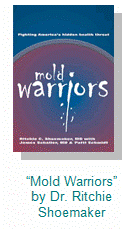 cellulose-filled materials; EPA reports 30% of USA structures have indoor mold. Mold spores contain potent nerve toxins or neurotoxins. When these spores are inhaled, about three out of four people can produce antibodies to the toxins and quickly eliminate them. But one out of four has a genetic makeup that does not identify the toxins as invaders and does not eliminate them effectively. The liver can send them to the digestive tract via the bile, but they are quickly reabsorbed back into the blood. The result is that continual or repeated exposures to mold toxins result in an ever increasing amount of these toxins in the body. When Lyme is also present, Lyme toxins also build up in the body the same way. Mold and Lyme toxins attach to fat cells and cause the fat cells to continually release inflammatory cytokines. The result is chronic inflammation, often with symptoms such as fatigue, pain, brain fog and out of control weight gain.[26]
cellulose-filled materials; EPA reports 30% of USA structures have indoor mold. Mold spores contain potent nerve toxins or neurotoxins. When these spores are inhaled, about three out of four people can produce antibodies to the toxins and quickly eliminate them. But one out of four has a genetic makeup that does not identify the toxins as invaders and does not eliminate them effectively. The liver can send them to the digestive tract via the bile, but they are quickly reabsorbed back into the blood. The result is that continual or repeated exposures to mold toxins result in an ever increasing amount of these toxins in the body. When Lyme is also present, Lyme toxins also build up in the body the same way. Mold and Lyme toxins attach to fat cells and cause the fat cells to continually release inflammatory cytokines. The result is chronic inflammation, often with symptoms such as fatigue, pain, brain fog and out of control weight gain.[26]
KEEPING THE GENIE IN THE BOTTLE
The disease can be controlled, but it may never be eradicated. It waits, like a genie in a bottle, for the right moment to pop out. Although some still want to dispute the concept of chronic Lyme, the abilities of latent bacteria are well documented elsewhere. People who had a childhood case of chicken pox can have a case of shingles, for example, much later in life. Shingles is a reactivation of the virus that has been in the body in a dormant form. The testimony of thousands of Lyme patients is that the genie comes out of the bottle when life delivers a major stress such as a death in the family, a surgery, or the loss of a career.
Most people with chronic Lyme seem to wrestle with it for the rest of their lives. The most successful learn to control it by avoiding foods which feed Lyme and its co-infections such as sugar, refined carbs, alcohol, gluten, and caffeine. They also use chelation to lessen the chronic inflammatory burden of metals and infections, and systemic enzymes to lessen fibrin and thin the blood. Cutting edge research is looking into the effects that genetically modified foods and EMF from cell phones and such may have on Lyme and its co-infections.
RESOURCES:
 “Under Our Skin”
“Under Our Skin”
This excellent documentary walks you through Lyme’s biology, and its political and economic dimensions. The film consists in large part of interviews with people who have suffered from chronic Lyme disease. You can order the CD on line or watch it in my office.
See movie trailer at http://www.youtube.com/watch?v=sxWgS0XLVqw&feature=channel
To find out how to host a screening of the movie, visit http://www.underourskin.com/screenings_host.html
This senior editor of Discover Magazine interviews key players in the Lyme disease controversy. She also reveals her personal odyssey after she, her husband and their two sons became seriously ill in the 1990s. In many cases, doctors are woefully unable or unwilling to diagnose Lyme. Then, once-treatable infections become chronic, inexorably disseminating to cause disabling conditions that may never be cured.
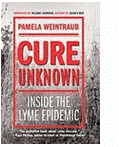 The Top 10 Lyme Disease Treatments: Defeat Lyme Disease With The Best Of Conventional And Alternative Medicine
The Top 10 Lyme Disease Treatments: Defeat Lyme Disease With The Best Of Conventional And Alternative Medicine
By Bryan Rosner
Lyme Disease is one of the most stubborn, treatment-resistant infections in the world and spreading rapidly on all continents. Recent research indicates that, in addition to tick bites, Lyme Disease may also be transmitted by sexual contact and bites from other insects. More difficult than diagnosing Lyme Disease is successfully treating it. In many cases, standard antibiotic treatment fails and symptoms persist.
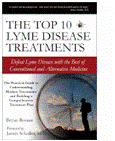 When Antibiotics Fail… Lyme Disease and Rife Machines
When Antibiotics Fail… Lyme Disease and Rife Machines
By Bryan Rosner
“Written for people who actually have a case of Lyme disease that is not responding to conventional antibiotic treatment. Lyme disease sufferers want to know their options, not how to identify a tick.” Rosner speaks about the use of frequency-generating machines to kill infectious bacteria.
 The Lyme-Autism Connection: Unveiling the Shocking Link Between Lyme Disease and Childhood Developmental Disorders
The Lyme-Autism Connection: Unveiling the Shocking Link Between Lyme Disease and Childhood Developmental Disorders
by Tami Duncan, Bryan Rosner
Science has found compelling similarities between Lyme disease and autism. At first glance, they may appear to be dissimilar conditions, new research increasingly shows that they are most certainly connect.
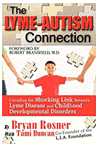 The Baker’s Dozen & the Lunatic Fringe: Has Junk Science Shifted the Lyme Disease Paradigm?
The Baker’s Dozen & the Lunatic Fringe: Has Junk Science Shifted the Lyme Disease Paradigm?
By PJ Langhoff
Midwest author and Lyme patient PJ Langhoff chronicles the politics, conflicts of interest, academic ties, research, and IDSA guidelines for Lyme disease. Third in a series, this book reveals key evidence offered during CT Attorney General Richard Blumenthal’s anti-trust investigation into the Infectious Disease Society of America’s (IDSA) clinical practice guidelines for Lyme
disease.
 Public Health Alert
Public Health Alert
A monthly newspaper of the Lyme community, available by subscription. Past issues available on line at http://www.publichealthalert.org
[1] Kirby C. Stafford III, PhD; The Tick Management Handbook, Fall 2007[2] Science 216:1317, 1982[3] Dr. Alan MacDonald, Gestational Lyme borreliosis. Implications for the fetus. Rheum Dis Clin North Am 89; 15(4):657-77[4] Dr. Gregory Bach, Do.O., P.C.; Recovery of Lyme Spirochetes by PCR in Semen Samples of Previously Diagnosed Lyme Patients, presented by Dr. Bach at the International Scientific Conference on Lyme Disease, April, 2001.[5] David Williams, MD; The New Great Impostor, Alternatives Newsletter, December 2004[6] http://www.cdc.gov/ncidod/dvbid/LYME/ld_transmission.htm[7] Ji B; Collins MT. Seroepidemiologic survey of Borrelia burgdorferi exposure of dairy cattle in Wisconsin. Am J Vet Res. 1994 Sep;55(9):1228-31.[8] Dr. J Burrascano, Diagnostic Hints and Treatment Guidelines for Lyme and Other Tick Born Illnesses, November 2002, accessed at http://www.ilads.org/lyme_disease/B_guidelines_12_17_08.pdf[9] Burrascano J. Advanced Topics in Lyme Disease. 16th edition. Downloaded June 7, 2009 from the International Lyme and Associated Diseases website, http://www.ilads.org/[9a] Evans R, Mavins S et al. Audit of the Laboratory Diagnosis of Lyme in Scotland. Journal of Medical Microbiology (2005), 54, 1139–1141. DOI 10.1099/jmm.0.46003-0.[10] P Coulter, C Lema, et al; Two-Year Evaluation of Borrelia burgdorferi Culture and Supplemental Tests for Definitive Diagnosis of Lyme Disease, Journal of Clinical Microbiology, October 2005, p. 5080-5084, Vol. 43, No. 10.[11] Lyme Disease Benches FSU Football Quarterback, Fox News, July 11, 2005[12] CBS News; Edwardsville, Il; Lyme Disease Linked To Illinois Church Shooting-Preacher Shot To Death During Sunday Sermon; March 9, 2009[13] Alan B. MacDonald, Plaques of Alzheimer’s disease originate from cysts of Borrelia burgdorferi, the Lyme disease spirochete, Medical Hypothesis, May 2006, Volume 67, Issue 3, Pages 592-600[14] Alan B. MacDonald, Alzheimer’s neuroborreliosis with trans-synaptic spread of infection and neurofibrillary tangles derived from intraneuronal spirochetes, Med Hypotheses, 2006 Oct 19[15] Behera AK, Hildebrand E, Szafranski J, et al. http://www.ncbi.nlm.nih.gov/pubmed/17009305″>Role of aggrecanase 1 in Lyme arthritis. Arthritis Rheum 2006; 54:3319–29.[16] M Budinger, Pasteur’s Legacy Feeds the Epidemics of Lyme and Autism, Townsend Newsletter, November 2008[17] Brorson, O, Grapefruit seed extract is a powerful in vitro agent against motile and cycstic forms of Borrilia burgdorferi sensu lato, Infection, June 2007; 35 (3): 206-8[18] Adelson ME, Rao RV, Tilton RC, et al. Prevalence of Borrelia burgdorferi, Bartonella spp., Babesia microti, and Anaplasma phagocytophila in Ixodes scapularis ticks collected in Northern New Jersey. J Clin Microbiol 2004; 42:2799–801.[19] R Forest, Daryl Hall speaks out on his battle with Lyme disease, Seacoast Media Group, June 12, 2008[20] Pamela Weintraub, Cure Unknown-Inside the Lyme Epidemic, St. Martin’s Press, 2008, p.169[21] http://www.idsociety.org/lymediseasefacts.htm, accessed May, 2009[22] http://www.ilads.org/index.html, accessed May, 2009[23] Raphael B. Stricker, Counterpoint: Long-Term Antibiotic Therapy Improves Persistent Symptoms Associated with Lyme Disease, Antibiotic Therapy and Lyme Disease CID 2007:45 (15 July) 149[24] http://www.ct.gov/ag/cwp/view.asp?a=2795&q=414284[24a] Public Health Alert, July 2010 http://www.publichealthalert.org/Articles/tinagarcia/IDSA%20Final%20Report.htm[25] Gary Wormser, MD; Donna McKenna, NP et al; Brief Communication: Hematogenous Dissemination in Early Lyme Disease; Annuals of Internal Medicine, Volume 142, Issue 9, Pages 751-755; May 3, 2005[26] Richard Loyd, Ph.D., Mold and Lyme Toxins, 2008 Lyme Disease Annual Report, accessed at http://lymebook.com/blog/the-recovery-process/mold-and-lyme-toxins/

